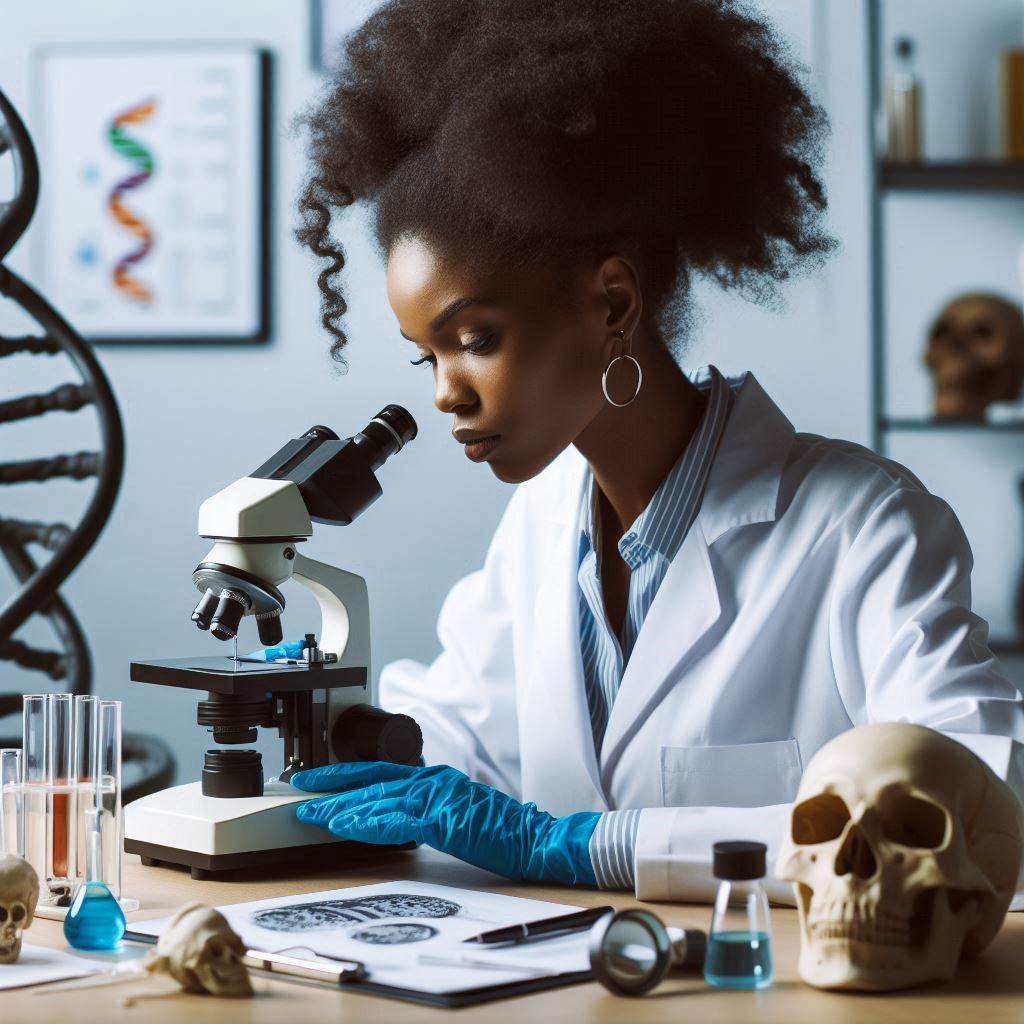Introduction
Forensic science plays a crucial role in criminal investigations by analyzing evidence to uncover key details about crimes.
It encompasses a wide range of scientific techniques, including DNA analysis, fingerprint examination, toxicology, and digital forensics, all of which help identify suspects, establish timelines, and verify alibis.
By examining physical evidence like blood samples, weapons, and trace materials, forensic scientists provide essential support to law enforcement in solving cases.
The importance of forensic science in solving criminal cases cannot be overstated.
It provides objective, scientifically-based data that can confirm or refute theories about how a crime occurred.
This ensures that investigations are grounded in fact rather than speculation, enhancing the accuracy and fairness of court proceedings.
Forensic science helps link suspects to crimes, rule out innocent parties, and even uncover new leads in unsolved cases.
In this blog post, we will explore how forensic science contributes to solving criminal cases.
We’ll examine the types of evidence forensic scientists analyze, the advanced tools and techniques they employ, and the impact of their findings on investigations and trials.
History of Forensic Science
Origins of Forensic Science
Forensic science has ancient roots, with early methods dating back to ancient China.
The Chinese used fingerprinting to identify individuals as early as 700 AD.
Later, in 1248, the book Hsi Duan Yu introduced forensic pathology, outlining methods to determine cause of death.
This marked one of the earliest uses of science in criminal investigations.
Europe saw advancements in forensic techniques during the 18th century.
In France, physician Mathieu Orfila, known as the father of toxicology, used chemistry to detect poisons in human bodies.
His work in 1814 helped set the foundation for future forensic methods, focusing on scientific accuracy in legal cases.
The development of forensic science continued to gain traction throughout the 19th century, as the legal system recognized the need for scientific methods to support criminal investigations.
Evolution of Forensic Techniques and Technology
Forensic techniques evolved rapidly during the 20th century.
The discovery of blood typing in 1900 by Karl Landsteiner allowed investigators to identify individuals using blood evidence.
This advancement opened the door to modern forensic serology.
The use of fingerprints in criminal investigations became more widespread in the early 1900s.
The establishment of fingerprint databases allowed law enforcement to link suspects to crime scenes with greater accuracy.
By 1910, French criminologist Edmond Locard developed the Locard Exchange Principle, stating that every criminal leaves behind trace evidence at a crime scene.
The discovery of DNA profiling in the 1980s revolutionized forensic science.
British geneticist Sir Alec Jeffreys first used DNA analysis to solve a double murder case in 1986.
This groundbreaking method provided an unprecedented level of accuracy in identifying suspects.
Today, forensic science has advanced with cutting-edge technologies such as facial recognition software, forensic anthropology, and 3D crime scene reconstruction.
These techniques continue to refine the ability to solve complex cases using scientific evidence.
Impact of Key Milestones in Forensic Science
The milestones in forensic science have dramatically improved how criminal cases are solved.
Blood typing helped law enforcement link suspects to crime scenes with higher accuracy.
The introduction of DNA profiling provided irrefutable evidence in cases that would have otherwise gone unsolved.
Fingerprinting, toxicology, and DNA analysis have collectively changed the landscape of criminal investigations.
These advancements have not only improved crime-solving but also helped exonerate wrongfully convicted individuals.
Additionally, the development of forensic databases, such as the FBI’s CODIS system, has significantly streamlined criminal investigations by allowing faster and more accurate identification.
Therefore, the origins, evolution, and key milestones in forensic science have dramatically enhanced criminal investigations.
From early fingerprinting to modern DNA technology, forensic science continues to be a cornerstone in solving crimes.
Read: Exploring the Different Branches of Geology
Different areas of forensic science
DNA Analysis
DNA analysis is one of the most powerful tools in forensic science.
It identifies individuals based on their unique genetic makeup.
Investigators collect DNA samples from crime scenes, such as blood or hair.
They then use techniques like polymerase chain reaction (PCR) to amplify these samples.
After amplification, forensic scientists compare the DNA profiles with databases.
This comparison can reveal matches with known offenders.
In many cases, DNA evidence leads to swift arrests and convictions.
Moreover, it can exonerate innocent individuals wrongfully accused of crimes.
Fingerprinting
Fingerprinting is another essential forensic technique.
Every individual has unique fingerprints, making them a reliable means of identification.
Investigators collect fingerprints from crime scenes using powders or chemical methods.
Forensic experts then compare these prints to known databases.
This comparison helps identify potential suspects.
Fingerprint analysis can establish a suspect’s presence at a crime scene.
It is often used in burglary, assault, and homicide investigations.
Ballistics
Ballistics is the study of firearms and ammunition.
Forensic ballistics experts analyze bullet trajectories and cartridge cases.
They determine the type of weapon used in a crime.
Investigators collect fired bullets and shell casings from crime scenes.
Experts examine markings on these items to identify the firearm.
Ballistics analysis can link a suspect to a shooting incident.
This evidence is crucial in cases involving gun violence.
Toxicology
Toxicology focuses on the study of drugs and poisons in the body.
Forensic toxicologists analyze biological samples, such as blood and urine.
They detect the presence of substances that could indicate foul play.
Toxicology reports provide insights into cause of death in suspicious cases.
For example, they can reveal whether a victim overdosed or was poisoned.
This information is vital for legal proceedings and helps establish motive.
Digital Forensics
Digital forensics investigates electronic devices and data.
As technology evolves, criminals increasingly use digital means to commit offenses.
Digital forensic experts analyze computers, smartphones, and servers for evidence.
They recover deleted files, emails, and chat logs.
This information can provide crucial insights into criminal behavior.
Digital forensics helps solve cybercrimes, fraud cases, and other offenses.
Basically, forensic science offers a range of techniques to solve criminal cases.
DNA analysis, fingerprinting, ballistics, toxicology, and digital forensics all contribute to investigations.
Each method provides unique insights that help law enforcement uncover the truth.
By leveraging these techniques, forensic scientists play a crucial role in ensuring justice is served.
Read: Top Skills Needed for a Successful Geology Career
Role of forensic scientists in criminal investigations
Collection and Analysis of Evidence
The collection and analysis of evidence are fundamental to forensic science.
Investigators gather physical evidence from crime scenes, such as fingerprints, blood, and hair.
Proper collection techniques ensure that the evidence remains uncontaminated.
Forensic scientists follow strict protocols to maintain the chain of custody.
Once collected, forensic scientists analyze the evidence using various techniques.
They employ DNA analysis, toxicology, and chemical testing to extract vital information.
Each method helps identify potential suspects and establish connections to the crime.
For example, DNA profiling can link a suspect to a victim or crime scene.
Furthermore, forensic analysis aids in reconstructing events.
By examining evidence, forensic experts can determine how a crime occurred.
They piece together timelines and sequences of events, helping law enforcement build a clear picture of the incident.
This analysis often proves crucial in establishing a case against a suspect.
Working with Law Enforcement Agencies
Forensic scientists work closely with law enforcement agencies throughout investigations.
Their expertise is invaluable in guiding investigators on evidence collection and processing.
Law enforcement relies on forensic science to enhance the overall effectiveness of criminal investigations.
Collaboration occurs at multiple stages of an investigation.
Forensic scientists may attend crime scenes to assist in evidence collection.
Their knowledge helps ensure that critical evidence is not overlooked.
Additionally, they provide training to law enforcement personnel on forensic techniques.
Communication between forensic scientists and law enforcement is essential.
Regular updates and discussions help both parties stay informed.
This collaboration fosters a cohesive approach to solving cases, ultimately benefiting the investigative process.
Providing Expert Testimony in Court
Providing expert testimony in court is a vital aspect of forensic science.
Forensic scientists often serve as expert witnesses during trials.
Their role is to explain scientific findings in a clear and understandable manner.
In court, forensic scientists present the evidence they analyzed.
They discuss the methodologies used and the significance of their findings.
This testimony can significantly influence a jury’s understanding of the case.
A well-presented analysis can strengthen the prosecution’s argument and help secure a conviction.
Moreover, forensic experts must adhere to strict ethical standards.
They provide unbiased opinions based solely on scientific evidence.
This integrity ensures that the court receives accurate information, contributing to a fair judicial process.
In general, forensic science is integral to solving criminal cases.
The collection and analysis of evidence provide essential insights.
Collaboration with law enforcement enhances investigative efforts.
Providing expert testimony in court solidifies the role of forensic science in the justice system.
Through these processes, forensic science helps ensure that justice is served.
Read: The Future of Botany: Emerging Fields and Innovations
Case studies of how forensic science has solved crimes
Famous Cases Where Forensic Evidence Played a Crucial Role
Forensic science has dramatically transformed the criminal justice system.
It has played a pivotal role in solving many famous cases.
One notable example is the O.J. Simpson trial in the 1990s.
DNA evidence became a central focus in this high-profile murder case.
Experts analyzed blood samples found at the crime scene.
The results linked Simpson to the murders of Nicole Brown Simpson and Ron Goldman.
Another famous case is the Golden State Killer investigation.
For decades, the identity of this criminal remained a mystery.
In 2018, law enforcement used genealogical DNA testing to identify Joseph James DeAngelo.
This technique involved comparing DNA from crime scenes to public DNA databases.
The breakthrough led to his arrest and eventual conviction for multiple murders and rapes.
The case of the 1996 murder of JonBenét Ramsey also showcases forensic science’s impact.
Investigators used various forensic techniques to analyze the evidence.
They examined fiber samples from the crime scene and the victim’s clothing.
Forensic experts also conducted DNA tests on unidentified samples found at the scene.
Although the case remains unsolved, these techniques provided critical insights.
Explanation of How Different Forensic Techniques Were Used to Solve the Cases
In the O.J. Simpson case, forensic scientists employed DNA analysis as a primary tool.
They collected blood samples from the crime scene and compared them to Simpson’s DNA.
This comparison confirmed a match, which served as vital evidence during the trial.
Additionally, hair and fiber analysis supported the link between Simpson and the crime scene.
In the Golden State Killer case, investigators utilized genealogy databases for their breakthrough.
They compared DNA collected from crime scenes to profiles in public DNA databases.
This innovative approach led them to distant relatives of DeAngelo, ultimately identifying him as a suspect.
The use of genealogical DNA analysis marked a significant advancement in forensic techniques.
For the JonBenét Ramsey case, forensic experts employed various methodologies.
They utilized fiber analysis to connect possible suspects to the crime scene.
This technique helped narrow down the list of potential perpetrators.
Additionally, DNA testing on evidence such as touch DNA provided insights into the assailant’s identity.
These techniques underscored the importance of forensic science in homicide investigations.
Forensic techniques continue to evolve, making them increasingly effective in solving cases.
Innovations in DNA analysis, fingerprinting, and ballistics significantly enhance investigations.
As seen in these famous cases, forensic evidence can make or break a trial.
It provides concrete links between suspects and crimes, ultimately aiding in justice.
Read: What Does a Geologist Do? Career Overview and Insights

Challenges and Limitations of Forensic Science
Contamination of Evidence
Contamination of evidence poses a significant challenge in forensic science.
It occurs when evidence is altered or tainted, leading to unreliable results.
Contaminated evidence can compromise the integrity of a criminal investigation.
For instance, if a crime scene is not secured properly, outside elements may interfere with crucial evidence.
To prevent contamination, forensic professionals must follow strict protocols.
They wear gloves and use proper collection techniques to preserve evidence integrity.
Chain of custody is essential in maintaining evidence reliability.
Each piece of evidence must be documented meticulously from the crime scene to the laboratory.
Despite precautions, contamination can still happen.
Human error or negligence during evidence handling can introduce new variables.
Forensic teams must remain vigilant to avoid cross-contamination between samples.
Any lapse in procedure can jeopardize the entire investigation, potentially leading to wrongful convictions or acquittals.
Human Error in Analysis
Human error in forensic analysis can also impact case outcomes.
Even skilled professionals can make mistakes during the analysis process.
Misinterpretation of data or incorrect labeling of samples can lead to flawed conclusions.
Such errors can have serious consequences in criminal cases.
Forensic analysts often rely on subjective judgment when interpreting results.
This subjectivity can introduce bias, affecting the analysis.
Standardization and validation of testing methods can help minimize these risks.
Regular training and certification ensure forensic professionals maintain high standards.
Moreover, workload and stress can contribute to human error.
High caseloads may lead to rushed analysis, increasing the likelihood of mistakes.
Laboratories must prioritize adequate staffing and resources to support accurate analysis.
Transform Your Career Today
Unlock a personalized career strategy that drives real results. Get tailored advice and a roadmap designed just for you.
Start NowTechnological Limitations
Technological limitations also play a role in forensic science challenges.
While advances in technology enhance forensic analysis, limitations still exist.
For example, certain substances may not be detectable with current methods.
Some tests may require specialized equipment that is not available in every laboratory.
Additionally, not all forensic techniques provide conclusive results.
For example, DNA analysis can sometimes yield partial profiles, complicating identifications.
Environmental factors may also affect the reliability of results.
Budget constraints often limit access to advanced technology in some laboratories.
Smaller agencies may struggle to afford the latest tools, impacting their analysis capabilities.
As a result, they may rely on older methods that are less effective.
In essence, while forensic science plays a vital role in solving criminal cases, challenges remain.
Contamination of evidence, human error in analysis, and technological limitations can undermine its effectiveness.
Addressing these challenges is crucial for ensuring accurate and reliable forensic investigations.
Ongoing training, stringent protocols, and investment in technology can help mitigate these issues.
Future trends in forensic science
Advancements in DNA Technology
DNA technology has revolutionized forensic science in recent years.
Modern DNA analysis techniques allow forensic experts to identify suspects more accurately.
Polymerase chain reaction (PCR) technology enables the amplification of tiny DNA samples.
This advancement increases the chances of obtaining usable DNA from crime scenes.
Additionally, next-generation sequencing (NGS) allows forensic scientists to analyze complex DNA mixtures.
This capability is particularly useful in cases with multiple suspects.
NGS provides a clearer picture of DNA profiles, making it easier to identify individuals.
Moreover, advancements in mitochondrial DNA analysis help in cases where nuclear DNA is not available.
Mitochondrial DNA can be extracted from hair, bones, and other materials.
This method provides valuable evidence in cases involving unidentified remains or historical investigations.
Forensic DNA databases, such as CODIS, have also improved the efficiency of investigations.
These databases store DNA profiles from convicted offenders and crime scenes.
Law enforcement agencies can quickly match DNA evidence to known offenders, speeding up the investigative process.
Use of Artificial Intelligence in Forensic Analysis
Artificial intelligence (AI) is transforming forensic analysis and case investigations.
AI algorithms can analyze vast amounts of data quickly and accurately.
This capability enables forensic scientists to uncover patterns and correlations that human analysts might miss.
For example, AI can assist in facial recognition technology, identifying suspects from surveillance footage.
This technology has significantly improved the speed of identifying potential suspects in criminal cases.
It helps law enforcement agencies respond more effectively to ongoing investigations.
AI also plays a role in analyzing digital evidence.
Machine learning algorithms can sift through large data sets, identifying relevant information for investigators.
This efficiency is vital in cybercrime cases, where the volume of data can be overwhelming.
Furthermore, AI tools can assist in crime prediction models.
These models analyze historical crime data to identify potential crime hotspots.
Law enforcement agencies can allocate resources more effectively, preventing crimes before they occur.
Potential Impact of Emerging Technologies on Criminal Investigations
Emerging technologies have the potential to reshape criminal investigations significantly.
Innovations like blockchain can enhance the integrity of evidence storage and chain of custody.
Blockchain technology provides a secure and transparent way to track evidence from collection to court.
Moreover, advancements in biometrics, such as fingerprint and voice recognition, continue to evolve.
These technologies provide additional layers of identification and evidence collection.
They increase the accuracy and reliability of forensic evidence.
Furthermore, virtual reality (VR) and augmented reality (AR) can play a role in crime scene reconstruction.
These technologies allow investigators to visualize crime scenes in immersive ways.
They help juries and investigators understand the context of the crime better.
Ultimately, advancements in DNA technology, the use of artificial intelligence, and emerging technologies significantly impact forensic science.
These innovations enhance the accuracy and efficiency of criminal investigations.
As technology continues to evolve, forensic science will play an even more critical role in solving criminal cases.
Ethical considerations in forensic science
Privacy Concerns Related to DNA Databases
DNA databases play a critical role in modern forensic science.
They store genetic information from crime scenes and convicted individuals.
However, privacy concerns often arise regarding the use of these databases.
Many people worry about how their DNA information is stored and used.
Unauthorized access to these databases can lead to identity theft or misuse of personal data.
Additionally, there are concerns about the potential for discrimination.
Law enforcement agencies might use DNA data to target specific populations unjustly.
This can lead to racial profiling and other forms of bias.
Striking a balance between solving crimes and protecting individual privacy is essential.
As forensic science evolves, so should regulations governing DNA databases.
Ensuring transparency and strict access controls can help address privacy concerns.
Public trust is crucial for the effective use of DNA technology in criminal investigations.
Misuse of Forensic Evidence in Court
Forensic evidence must maintain a reputation for reliability and accuracy.
However, there are instances where misuse occurs in court settings.
Misinterpretation of forensic findings can mislead juries and affect trial outcomes.
For example, overreliance on bite mark analysis or hair comparison can lead to wrongful convictions.
These techniques often lack scientific validation, yet they may sway jurors’ opinions.
Furthermore, pressure to solve cases can lead forensic experts to cut corners.
They might overlook protocols or fail to document evidence properly.
Such actions undermine the integrity of forensic evidence presented in court.
Defense attorneys must scrutinize forensic evidence to ensure its validity.
This vigilance protects the rights of defendants and upholds the justice system.
Importance of Maintaining Integrity and Impartiality in Forensic Investigations
Integrity and impartiality are fundamental to forensic investigations.
Forensic scientists must remain objective throughout their work.
Bias, whether conscious or unconscious, can skew results and conclusions.
Maintaining a high standard of ethics ensures that forensic evidence is reliable.
Additionally, forensic experts should communicate findings transparently.
Clear explanations allow jurors and judges to understand the evidence presented.
Proper training in forensic practices and ethical standards is crucial for professionals in the field.
Continuous education helps forensic scientists stay updated on best practices and emerging technologies.
Furthermore, independent audits of forensic labs can enhance credibility.
Regular assessments ensure that procedures are followed and that integrity is maintained.
These audits can identify potential issues before they impact investigations.
Ensuring quality control in forensic laboratories builds public confidence in the criminal justice system.
Forensic science plays a vital role in solving criminal cases.
However, privacy concerns, misuse of evidence, and the need for integrity must be addressed.
By focusing on these areas, the field can maintain its credibility and effectiveness.
Upholding ethical standards will ultimately lead to more just outcomes in the legal system.
Conclusion
Forensic science plays an indispensable role in solving criminal cases, providing the necessary tools to analyze evidence, identify suspects, and bring criminals to justice.
By applying scientific techniques such as DNA analysis, toxicology, ballistics, and fingerprint identification.
Forensic scientists offer critical insights that support investigations and contribute to solving even the most complex crimes.
Their work not only helps in finding the truth but also strengthens the legal process by ensuring that the evidence presented in court is accurate, reliable, and scientifically validated.
The importance of continued support for the advancement of forensic science cannot be overstated.
As technology evolves, the potential for forensic science to enhance crime-solving efforts grows exponentially.
From improvements in DNA testing to the development of more sophisticated digital forensics, advancements in this field directly impact the efficiency and accuracy of criminal investigations.
Supporting research, funding new technologies, and investing in forensic education are crucial steps in keeping this field at the forefront of justice.
Forensic science’s impact on the justice system has been profound, reshaping how criminal cases are investigated and prosecuted.
It provides an objective, evidence-based approach that allows law enforcement and the legal system to pursue cases with confidence.
[E-Books for Sale]
The Big Book of 500 High-Paying Jobs in America: Unlock Your Earning Potential
$19.99 • 500 High-Paying Jobs • 330 pages
Explore 500 high-paying jobs in America and learn how to boost your career, earn more, and achieve success!
See All 500 High-Paying Jobs of this E-Book
1001 Professions Without a Degree: High-Paying American Jobs You Can Start Now
$19.99 • 1001 Professions Without a Degree • 174 pages
Discover 1001 high-paying jobs without a degree! Unlock career tips, skills, and success strategies for just $19.99!




